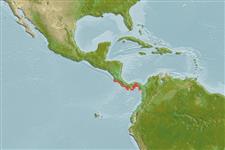>
Blenniiformes (Blennies) >
Chaenopsidae (Pike-, tube- and flagblennies)
Etymology: Acanthemblemaria: Greek, akantha = thorn + Greek, emblema, -atos, anything that is nailed, knocked in; also anything with bass or high relief (Ref. 45335).
Environment: milieu / climate zone / depth range / distribution range
นิเวศวิทยา
เกี่ยวกับทะเล,น้ำเค็ม เกี่ยวกับหินโสโครก; ระดับความลึก 1 - 5 m (Ref. 11482). Tropical; 11°N - 4°N, 87°W - 76°W (Ref. 56267)
Eastern Central Pacific: Costa Rica to Ecuador.
ขนาด / น้ำหนัก / Age
Maturity: Lm ? range ? - ? cm
Max length : 5.5 cm TL เพศผู้/กระเทย; (Ref. 11482)
Inhabits empty worm and mollusk tubes on rocky reefs. Feeds on zooplankton.
Life cycle and mating behavior
Maturities | การสืบพันธุ์ | Spawnings | Egg(s) | Fecundities | ตัวอ่อน
Allen, G.R. and D.R. Robertson, 1994. Fishes of the tropical eastern Pacific. University of Hawaii Press, Honolulu. 332 p. (Ref. 11482)
IUCN Red List Status (Ref. 130435)
Threat to humans
Harmless
Human uses
เครื่องมือ
Special reports
Download XML
แหล่งที่มาจากอินเตอร์เน็ต
Estimates based on models
Preferred temperature (Ref.
123201): 27.3 - 28.7, mean 27.9 °C (based on 47 cells).
Phylogenetic diversity index (Ref.
82804): PD
50 = 0.5000 [Uniqueness, from 0.5 = low to 2.0 = high].
Bayesian length-weight: a=0.00457 (0.00183 - 0.01143), b=3.08 (2.86 - 3.30), in cm total length, based on LWR estimates for this (Sub)family-body shape (Ref.
93245).
ระดับชั้นอาหาร (Ref.
69278): 3.4 ±0.45 se; based on food items.
Fishing Vulnerability (Ref.
59153): Low vulnerability (10 of 100).
Nutrients (Ref.
124155): Calcium = 196 [94, 392] mg/100g; Iron = 0.932 [0.505, 1.670] mg/100g; Protein = 18.1 [16.8, 19.2] %; Omega3 = 0.0922 [, ] g/100g; Selenium = 14.1 [5.9, 35.9] μg/100g; VitaminA = 376 [108, 1,312] μg/100g; Zinc = 2.33 [1.45, 3.60] mg/100g (wet weight);
